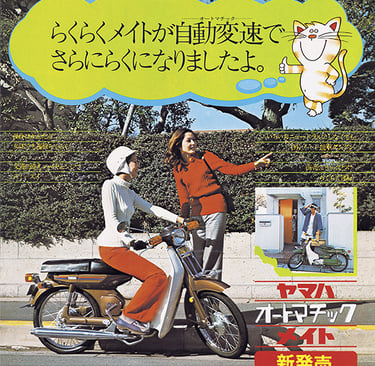Yamaha's marketing approach during the 1960s and 1970s
Yamaha's marketing strategy for their commuter mopeds, specifically the Mate series, during the 1960s and 1970s was innovative and effective in establishing the brand as a strong competitor against rivals like Honda's Cub series. Their approach included emphasizing practicality and convenience, unique branding, a memorable jingle and TV commercial, product diversification, cultivating new markets, and focusing on female riders.
MOPED CULTURE YAMAHA JAPAN 1960'S1970'STWO STROKE
11/6/20232 min read


Yamaha's marketing approach during the 1960s and 1970s
Yamaha's marketing strategy for their commuter mopeds, particularly the Mate series, in the mid-1960s was innovative and effective in establishing the brand as a strong competitor against fierce competition, notably from Honda's Cub series. Here's an analysis of Yamaha's marketing efforts during that time:
Emphasizing Practicality and Convenience: Yamaha recognized that small, moped-style motorcycles were practical for everyday transport, which included delivering packages and running errands. Their marketing focused on highlighting these benefits to target a growing market of riders who needed practical and efficient transportation.
Unique Branding: Yamaha's marketing team took an unconventional approach by conducting a campaign to name their new moped. They encouraged suggestions from both within and outside the company, generating a massive response of around 215,000 ideas. This approach engaged the community and built anticipation around the product. The name "Mate" was chosen after careful consideration, giving the moped a friendly and approachable image.
Effective Jingle: Yamaha's collaboration with a famous songwriter to create a jingle for the Mate's commercial was a smart move. The jingle became a memorable and catchy element of their advertising campaign, helping to create brand recognition and recall.
Memorable TV Commercial: Yamaha's commercial featuring a chimpanzee riding the Mate was both entertaining and memorable. The unique and fun concept resonated with both children and adults, contributing to the popularity of the jingle and the moped itself.
Product Diversification: Yamaha expanded its product line by introducing new models and versions of the Mate series. They launched the "Rakuraku Mate" with different engine sizes, catering to a broader audience. Later, the introduction of automatic 2-speed transmission versions further diversified their product offerings.
Cultivating New Markets: Yamaha's introduction of the automatic transmission in the V50A Mate and V70A served as an industry milestone. While it took some time for the market to adopt this innovation, it eventually created a new market category, showing Yamaha's commitment to pushing the boundaries of their product offerings.
Female Rider-Focused: The Mate series' ease of handling, lack of a gear change pedal, and emphasis on convenience resonated well with female riders. Yamaha's strategy to appeal to this demographic helped them tap into a previously underserved market segment.
In summary, Yamaha's marketing approach during the 1960s and 1970s for their commuter mopeds was characterized by creativity, community involvement, memorable advertising, and product diversification. These strategies helped Yamaha effectively compete with rivals like Honda's Cub series and establish itself as a recognizable and reputable brand in the two-wheeler market.
